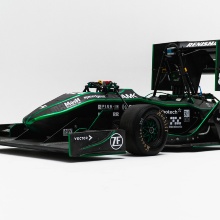In the 2019/2020 season, all Formular Racing competitions were cancelled due to the Corona pandemic. This presented the University of Stuttgart's GreenTeam with a huge challenge. "When all the events were cancelled, we lost our motivation. But we were able to pick ourselves up again quickly", says Laura Kleckner, who is responsible for the overall management of the GreenTeam's Driverless division. The students wanted to make the best of the situation, and there were two ways to do this: they could either complete the racing cars that had been in production when the pandemic hit, test these and make any necessary updates. Or, they could stop production completely to save resources and begin working on new developments. The GreenTeam chose the second option. "Looking back, this was absolutely the right decision. The entire team pulled together and we were able to motivate many of the team members", says Daniel Martin, GreenTeam team leader.
The electric racing car E0711-11 EVO
The electric racing car E0711-11 EVO is named after EVO, a record-breaking racing car from the Stuttgart area. In this season, we focused on developing the EVO. "Over the course of the last two years, we have redeveloped almost every component", says Karsten Müller, who is responsible for overall vehicle management. The students developed a new wheel package, which delivers more freedom in terms of aerodynamics and kinematics. They also created a solid carbon rim, a new brake caliper and a 3D-printed wheel carrier.
The vehicle engine is currently in the third generation. For the drive, it is not only the output that is important, but also the continuous output and efficiency. “We have made significant advancements here in the last year”, says Müller. “We were able to improve the continuous output of our engines by integrating a rotor cooling system. And we also achieved further progress with an AI-optimized start cooling system.” Furthermore, the students were also able to improve the efficiency of the entire drive train by over three percent by using an inverter they developed themselves. By using a narrower battery, the team was able to build a narrower monocoque, thus generating more wing surface for the aerodynamics. With these changes, the students hope improve their lap times at Formula Student.
The fully autonomous D0711-04 racing car
The Driverless team focused on the development of autonomous systems, including developing the camera and object recognition. The racetrack that the car will drive on is marked with traffic cones. “The camera delivers a 4k image and this is divided into different resolution zones”, explains Marcel Dzubba, who worked on feedback control.
Using a neuron network, the position of the cones is classified in the camera image. This is then adaptively adjusted and delivered to the vehicle dynamics using an algorithm, developed by the students themselves, that estimates the distance from the camera to the cones. The data is then used to develop a map of the cones and to determine the position of the racing car. In this way, the racing car is able to autonomously navigate its way through the parkour.
On July 1 at 5 p.m., the University of Stuttgart's racing team will also present its latest raceing car. The event can be viewed on the racing team's YouTube channel [de].
Formula Student
Formula Student is an international construction competition for students that has been held annually since 2006. The races take place both at home and abroad, for example in Hungary, Austria or at Hockenheimring. The competition is not won solely by the team with the fastest or most durable car, but rather by the team with the best overall package. This includes the presentation of a business plan and a cost report.




